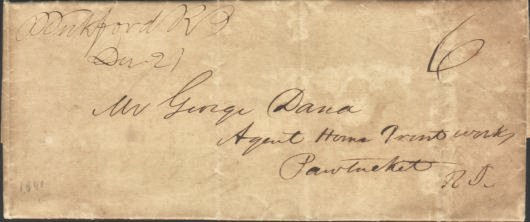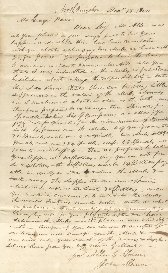![]()
Postal History Introduction
Stampless
Covers
1846
to 1900 Issues
1901-1950
Issues
1951-2003
Issues
Cancels
&
Miscellaneous
Postal
Stationery
Post
Cards
Air
Mail
First
Day &
Event Covers
Parcel Post/Special Delivery
Registered & Official Mail
Commercial & Advertising
Revenue & Postage Due
Wildlife & Game Issues
Complete List of RI Issues
|
Rhode Island Stampless
Covers & Letters |
|||||||||||||||
|
|||||||||||||||
|
The Stampless Folded Letter
shown above and to the left was sent by John Slocum
acting for Allen Slocum and posted at Wickford, Rhode Island. It was sent
to George Dana, the agent for Horns Print Works
in Pawtucket. The letter was charged at the single
sheet rate of 6 cents Due established by the
Postal Act of April 9, 1816; effective
May 1, 1816 for distances not exceeding
30 miles. There is also a Wickford, RI
script cancellation at the top left of the cover
for December 21st. The letter concerns the
trade or purchase of some Spinning Mules
in exchange for Water Frames and also the purchase
of a Lapper; the difference in spindle count to be
made up in cash. A large percentage of the Rhode Island Stampless Folded Letters from the early to mid 19th centuries deal with cotton and textile mills. The terminology used in the industry tends to be a bit confusing, thus the background information below will explain a few of the terms and relate a little of the history concerning the textile industry along with some of the early innovations used in the manufacture of textiles. The complete text of the letter is appended beneath the history and explanation. |
|||||||||||||||
|
The start of the
Industrial Revolution as it
relates to the textile industry began in
Great Britain
in 1767
where Richard Arkwright
invented and perfected his water frame. The
Water Frame,
(so-called because the frames
used water power to operate)
could spin 128 threads
and did not need a
skilled
operator, whereas the previously invented
Spinning Jenny
could spin a dozen threads,
but needed
a skilled operator.
Arkwright teamed up with
Jedediah Strutt in
1769
and they built their first
water powered factory in
1771
on the Derwent River
in Derbyshire,
England. Samuel Slater,
the father
of the Industrial Revolution
in America learned the
trade when he was apprenticed
to Jedediah Strutt in 1781.
Slater worked
for Jedediah for a period of
8 years and learned the
business from the ground up, eventually
becoming
the Superintendent
of the Mill.
Samuel Slater emigrated to America in 1789 and after being financed by Moses Brown, one of the four Brown Brothers of Providence, Rhode Island, he constructed the first modern spinning mill in Pawtucket. (SEE ALSO: Rhode Island Bicentennial First Day Cover - Slater's Mill History.) Samuel Slater became known as the "Father of the American Industrial Revolution" and Rhode Island became one of the leaders in the textile industry with factories springing up throughout the state, wherever there were rivers that could supply power to the mills. The Slocums are a well known and numerous family in the North Kingstown area and I attended High School with several members of the family. There is even a small village in the area named for the family; "Slocumville." John and Allen Slocum were partners with a Mr. Gardiner, (Slocum & Gardiner) and in 1839 they took over what later became the Hamilton Web Company in 1857 and began spinning cotton and yarns. They operated the mill for 11 years. This letter was written about 18 months after they began operation and appears to be part of their efforts to modernize the mill. |
|||||||||||||||
|
TEXTILE TERMINOLOGY AND DEFINITIONS
Spinning Wheel: an early machine that turned fibers into thread or yarn, which was then woven into cloth on a loom. It was most likely invented in India, reaching Europe during the Middle Ages where it replaced the ancient method of hand spinning the fibers into yarn. Spinning Jenny: Invented by James Hargreaves in 1764, the Jenny was the first practical application of a multiple spinning machine. The original Spinning Jenny used eight spindles instead of the one found on the spinning wheel. A single wheel on the Jenny controlled the eight spindles, which created a weave using eight threads spun from a corresponding set of rovings. Later models had up to one-hundred and twenty spindles. The drawbacks to the Jenny were that it produced a very coarse thread and could not be used on yarns that extended lengthways on the loom, (Warp Threads). It also required a skilled operator to run the machine. Water Frame: A machine invented by Thomas Highs and perfected by the Clockmaker, John Kay for Richard Arkwright. Arkwright is most often given credit for this invention, but in actuality he stole the idea from Highs; he was responsible, however for it's first practical large scale application. The Water Frame was powered by a water wheel and used three sets of rollers, each spinning at a faster speed than the previous, to draw out the cotton roving before the twist was imparted. The thread produced was still course, but the machine's advantage over the Jenny was that it could produce a larger quantity of threads and did not require any skill to operate. Spinning Mule: The Spinning Mule was invented by Samuel Crompton in 1779 and was a combination of the Jenny and the Water Frame. The machine combined the moving carriage of the Jenny with the rollers of the Water Frame and produced a thread, which was both finer and stronger than that produced by the Jenny or Water Frame. The thread that was produced by the Mule is considered by most experts to be of the highest quality and comparable to hand worked yarns. I found two definitions for
Lappers, however I am still not sure which type of
lapper is referred to in the letter. The Complete Text of the Letter follows Below: |
|||||||||||||||
|
|||||||||||||||

RI Historical
Society
Introduction
Stampless I
Stampless II
Stampless III
Stampless IV
Stampless V
Stampless VI
Brown & Ives Letters
The Hazard Family Letters
Joseph Tillinghast
Free Franked Letters
DeWolf Family Letters
Recently Added Pages

